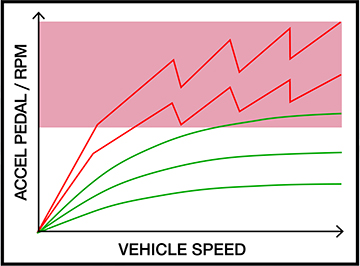
Nissan’s continuously variable transmissions (CVTs) are paired to work with the vehicles’ engine in order to give responsive passing performance. Pulling out to pass another vehicle is a good way to appreciate the responsiveness designed for the engine and transmission.
When you do not need maximum acceleration, the vehicle’s CVT response changes to enhance comfort. To demonstrate, while driving safely, accelerate to a speed of 45 MPH (72 km/h). Then, depress the throttle about three-quarters of the way to the floor and accelerate to the speed limit. Notice that the CVT simulates shifts — like a conventional automatic transmission shifting between gears. This provides a more linear acceleration feel and also relieves the engine noise that can come from constant high-rev acceleration.
INTRODUCING D-STEP TRANSMISSION TUNING
Many customers are bothered and have communicated that they believe that their transmissions are malfunctioning due to the lack of a discernible change in gears. D-Step Shift Logic should serve to relieve those concerns by giving drivers a more traditional driving experience.
To give drivers the option of feeling gearshifts while on the road, our Nissan® design engineers have added a D-Step Shift Logic feature to the CVT for many new vehicles in our lineup. D-Step Shift Logic is a software update that will give drivers the feeling that their vehicle is shifting gears like a conventional automatic transmission. The revised transmission tuning provides stepped ratio changes during moderate to heavy acceleration to reduce noise and produce a linear acceleration.

During rapid acceleration, once the vehicle reaches 4,000 RPM such as when merging onto a busy highway, the software commands the electronic brain of the Xtronic CVT gearbox to hold a ratio and then shift. It then helps create a subtle momentary drop in driving force to give a sense of gear change. It allows engine speed to build as vehicle speed builds, which also relieves the engine noise that can come from constant high-rev acceleration.
At cruising speed, the new tuning also allows the transmission to immediately change ratios when quick acceleration is needed, such as to pass another vehicle on a two-lane road.
During normal driving, the transmission retains the smooth, seamless response for which the Xtronic CVT is known.
DEMONSTRATING D-STEP
There is a simple 3-part demonstration that you can use to show customers how D-step tuning adds to the versatility of their transmission. Find a road or empty lot without traffic where you can accelerate from a standing start to accelerate three times – mildly, aggressively, and full-throttle, (make sure to observe the speed limit).
1. Mild acceleration – Press the accelerator no more than halfway, and accelerate as you would in normal city driving. Point out how the engine revs gently and then holds at a steady RPM level as the vehicle accelerates gradually and smoothly
2. Aggressive acceleration – Press the accelerator about three-quarters of the way to the floor. Point out that the engine revs high for strong acceleration. Once the vehicle speed reaches about 40 MPH, the response becomes more like a conventional automatic transmission shifting between gears. The revs drop to about 4,000 RPM and then build to about 5,000 RPM. Then it “shifts” again and repeats the process as long as you continue to accelerate.
3. Full-throttle acceleration – Fully depress the throttle and accelerate to the speed limit. Point out that the engine revs high and maintains an RPM level near the redline for maximum engine response.
The new tuning maintains the Xtronic CVT’s advantages in everyday driving and helps enhance its appeal. It is intended to provide smooth acceleration, keep the engine in its optimum power band, and eliminate “hunting” for the right ratio on hills. When quick or aggressive acceleration is needed, it provides responsive, stepped acceleration with a more linear feel.
